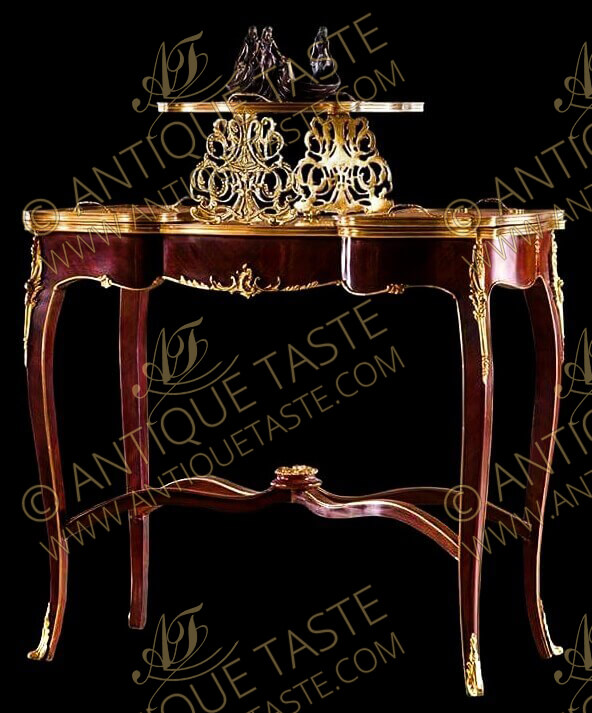Ref#1705 | Description
An Exquisite Louis XV style gilt-ormolu-mounted palisander wood tray-top serving table after the model by François Linke and Léon Messagé, Paris, Circa 1900,
Of serpentine shape, the upper section with lift-off tray, above delicate gilt-ormolu foliage supports, the segmented top fitted with a further two shaped ormolu mounted, lift-off trays, above a shaped body ornamented centered with a louis xv foliate shell mount extended to a delicate ormolu bands all over, raised on shaped ormolu acanthus headed cabriole tapering legs joined by a wavy 'X'-shaped stretcher surmounted by a foliate ormolu mount, with ormolu acanthus leaves sabots.
Ref# 1705
79-50-110cm
François Linke
Francois Linke (1855-1946) was arguably the leading Parisian cabinetmaker of the Belle Epoque the glittering age of fashionable French society, whose influence was felt throughout the world.
Determined to outshine the competition at the Exhibition, Linke had set about creating the most ambitious pieces he could envisage, and more extravagant than had ever been displayed before. The items he exhibited marked a transition from the historicist interpretation of Louis XV and Louis XVI styles, an interpretation that was the mainstay of his nearest rivals, to something startlingly new and vital in its immediacy. Together with Leon Message he developed a new style for the 1900 Exhibition that paid homage to the Louis XV rococo in the fluidity of its approach, but an approach fused with the lively flowing lines of the contemporary and progressive 'art nouveau'.
This risky endeavour was a resounding success, and with his reputation established, La Maison Linke became the pre-eminent furniture house until outset of the Second World War. The technical brilliance of his work and the artistic change that it represented was never to be repeated. His showrooms expanded into prestigious premises in Paris, in the Place Vendome as well as the Faubourg St. Antoine where his workshop had been established. He embarked on many important commissions in the years up to the outbreak of the First World War, making and designing furniture for leading international industrialists and bankers.
After the 1914-1918 World War, Linke undertook the extraordinary commission to furnish the Ras al-Tin Palace in Alexandria for King Fuad of Egypt, possibly the largest single furniture commission ever conceived, eclipsing even Versailles. Linke flourished and remained active until the middle years of the 1930s and died in 1946.
Léon Messagé
Leon Message (1842-1901) was a French sculptor, best known for his sculptural collaboration with Francois Linke for the 1900 Paris Exposition Universelle. Message was also responsible for much of the design and creative work for Roux et Brunet and Joseph-Emmanuel Zwiener.
Message was primarily influenced by rococo ornament but he strove to re-interpret it. He did not produce slavish copies, and his original approach can be appreciated in Linke's celebrated Grande Bibliotheque and Grand Bureau exhibited at the 1900 Paris Exposition Universelle. A number of drawings by Message are recorded and after his success at the exhibition of 1889 he was encouraged to publish his designs.[1] There were five sections to the book, with an elaborate title page surmounted by the sculptor's cipher or talisman of a wing, a pun on his own name as the messenger to the Gods, a motif he used many times on the handles of furniture designed for Linke.
As a sculptor Message was trained to produce a wax maquette or model prior to working on a piece. His maquettes were of the piece of furniture in its entirety, a rare and exacting task occasionally seen for eighteenth century French Royal commissions.
Tags
- #François_Linke_Tea_Table | #Table_À_Thé | #Two_Tier_Table | #Table_Etagere | #Jean_Henri_Riesener_Table | #French_style_Table | #joseph_emmanuel_zwiener_style_table | #Louis_XV_Table | #Louis_XIV_Table | #Louis_XVI_commode | #François_Linke_Furniture | #porcelain_inlaid_table | #antique_style_Gueridon_table | #ormolu_mounted_table | #antique_style_tea_table | #antique_style_side_table | #french_style_coffee_table | #couch_table | #antique_style_center_table | #boulle_style_table | #veneer_inlaid_table | #marquetry_table

